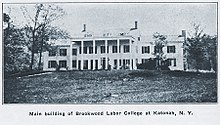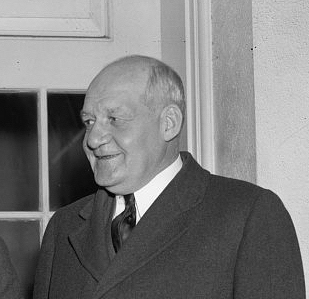Background

Joel Isaac Seidman was born in 1906. He attended the Baltimore City College [2] and earned a BA from the Johns Hopkins University in 1926. [3] He earned a doctorate with a thesis on yellow dog contracts. [1] [4]
Joel I. Seidman (1906-1977) was a 20th-century economics professor and Socialist, best known for his 1932 dissertation and book The Yellow Dog Contract as well as work with Brookwood Labor College. [1]

Joel Isaac Seidman was born in 1906. He attended the Baltimore City College [2] and earned a BA from the Johns Hopkins University in 1926. [3] He earned a doctorate with a thesis on yellow dog contracts. [1] [4]

In the mid-1930s, Seidman taught for three years [5] at the Brookwood Labor College, whose Brookwood Labor Publications published some of his works (e.g., A Labor Party for America? [1936] [6] ). As part of Brookwood's field work, Seidman met with UAW leaders including Walter Reuther to discuss the sitdown strike strategy, about which Seidman also wrote for the UAW. [7] [8] In the later 1930s, Seidman became director of Brookwood Labor College (which closed in 1937). [9]
For a period of fifteen years, Seidman was associated with trade unions, chiefly the International Ladies' Garment Workers Union (ILGWU), AFL, and the United Automobile Workers of America (UAW), CIO. [5]
In the late 1930s and into World War II (1939), League for Industrial Democracy organized summer institutes to educate students in union organizing and sponsored lecture tours by Seidman and LeRoy Bower. [10]
During the 1930s and 1940s, Seidman served for five years on the National Labor Relations Board, less time spent in military service during World War II. [5]
In the 1938 United States House of Representatives elections, Seidman ran for New York's 13th congressional district seat on the Socialist ticket.
Around 1947, [5] Seidman joined the Industrial Relations Center in the University of Chicago's Graduate School of Business, where he taught and directed research, [5] as well as serving as chairman of the Hyde Park Cooperative Society. [1]
Seidman wrote the first-ever book on yellow dog contracts. It traced their history from the 1830s in the United Kingdom, the 1870s in the United States, the use of the term "yellow dog" following World War I, to a land-mark event when the U.S. Senate rejected the nomination of Judge John J. Parker to the United States Supreme Court. [11]
A trade union or labor union, often simply referred to as a union, is an organization of workers whose purpose is to maintain or improve the conditions of their employment, such as attaining better wages and benefits, improving working conditions, improving safety standards, establishing complaint procedures, developing rules governing status of employees and protecting and increasing the bargaining power of workers.

The National Labor Relations Act of 1935, also known as the Wagner Act, is a foundational statute of United States labor law that guarantees the right of private sector employees to organize into trade unions, engage in collective bargaining, and take collective action such as strikes. Central to the act was a ban on company unions. The act was written by Senator Robert F. Wagner, passed by the 74th United States Congress, and signed into law by President Franklin D. Roosevelt.
Collective bargaining is a process of negotiation between employers and a group of employees aimed at agreements to regulate working salaries, working conditions, benefits, and other aspects of workers' compensation and rights for workers. The interests of the employees are commonly presented by representatives of a trade union to which the employees belong. A collective agreement reached by these negotiations functions as a labour contract between an employer and one or more unions, and typically establishes terms regarding wage scales, working hours, training, health and safety, overtime, grievance mechanisms, and rights to participate in workplace or company affairs. Such agreements can also include 'productivity bargaining' in which workers agree to changes to working practices in return for higher pay or greater job security.

The United Auto Workers (UAW), fully named International Union, United Automobile, Aerospace and Agricultural Implement Workers of America, is an American labor union that represents workers in the United States and southern Ontario, Canada. It was founded as part of the Congress of Industrial Organizations (CIO) in the 1930s and grew rapidly from 1936 to the 1950s. The union played a major role in the liberal wing of the Democratic Party under the leadership of Walter Reuther. It was known for gaining high wages and pensions for automotive manufacturing workers, but it was unable to unionize auto plants built by foreign-based car makers in the South after the 1970s, and it went into a steady decline in membership; reasons for this included increased automation, decreased use of labor, mismanagement, movements of manufacturing, and increased globalization. After a successful strike at the Big Three in 2023, the union organized its first foreign plant (VW) in 2024.
In labor law, a union shop, also known as a post-entry closed shop, is a form of a union security clause. Under this, the employer agrees to either only hire labor union members or to require that any new employees who are not already union members become members within a certain amount of time. Use of the union shop varies widely from nation to nation, depending on the level of protection given trade unions in general.
A yellow-dog contract is an agreement between an employer and an employee in which the employee agrees, as a condition of employment, not to be a member of a labor union. In the United States, such contracts were used by employers to prevent the formation of unions, most often by permitting employers to take legal action against union organizers. In 1932, yellow-dog contracts were outlawed in the United States under the Norris-LaGuardia Act.

A sit-down strike is a labour strike and a form of civil disobedience in which an organized group of workers, usually employed at factories or other centralized locations, take unauthorized or illegal possession of the workplace by "sitting down" at their stations. By taking control of their workplaces, workers engaged in a sit-down demonstrate their power, build solidarity among themselves, prevent the deployment of strikebreakers or removal of industrial equipment, and cause cascading effects on the chain of production within and between factories. However, sit-down strikes are illegal in the vast majority of countries, complicating their use.

A strikebreaker is a person who works despite a strike. Strikebreakers are usually individuals who were not employed by the company before the trade union dispute but hired after or during the strike to keep the organization running. Strikebreakers may also refer to workers who cross picket lines to work.
The National Labor Board (NLB) was an independent agency of the United States Government established on August 5, 1933, to handle labor disputes arising under the National Industrial Recovery Act (NIRA).

Brookwood Labor College was a labor college located at 109 Cedar Road in Katonah, New York, United States. Founded as Brookwood School in 1919 and established as a college in 1921, it was the first residential labor college in the country. Its founding and longest-serving president was A. J. Muste. The school was supported by affiliate unions of the American Federation of Labor (AFL) until 1928.

Retail, Wholesale and Department Store Union (RWDSU) is a labor union in the United States and Canada. Founded in 1937, the RWDSU represents about 60,000 workers in a wide range of industries, including but not limited to retail, grocery stores, poultry processing, dairy processing, cereal processing, soda bottlers, bakeries, health care, hotels, manufacturing, public sector workers like crossing guards, sanitation, and highway workers, warehouses, building services, and distribution.
Gary N. Chaison was an industrial relations scholar and labor historian at Clark University. Chaison died on February 17, 2022.
A collective agreement, collective labour agreement (CLA) or collective bargaining agreement (CBA) is a written contract negotiated through collective bargaining for employees by one or more trade unions with the management of a company that regulates the terms and conditions of employees at work. This includes regulating the wages, benefits, and duties of the employees and the duties and responsibilities of the employer or employers and often includes rules for a dispute resolution process.

The Blue Eagle at Work: Reclaiming Democratic Rights in the American Workplace is a legal treatise written by Charles J. Morris which analyzes collective bargaining under the National Labor Relations Act (NLRA), the federal statute governing most private sector labor relations in the United States. Published in 2005 by Cornell University Press, the text claims that the NLRA guarantees that employees under that Act have the right to bargain collectively through minority unions—but only on a members-only basis—in workplaces where there is not an established majority union, notwithstanding that the present practice and general understanding of the law is that only majority-union employees are entitled to engage in collective bargaining on an exclusivity basis. Contracts resulting from such minority-union bargaining would apply to union members only, not to other employees.
NLRB v. Mackay Radio & Telegraph Co., 304 U.S. 333 (1938), is a United States labor law case of the Supreme Court of the United States which held that workers who strike remain employees for the purposes of the National Labor Relations Act (NLRA). The Court granted the relief sought by the National Labor Relations Board, which sought to have the workers reinstated by the employer. However, the decision is much better known today for its obiter dicta in which the Court said that an employer may hire strikebreakers and is not bound to discharge any of them if or when the strike ends.
The State, County, and Municipal Workers of America (SCMWA) was an American labor union representing state, county, and local government employees. It was created by the Congress of Industrial Organizations (CIO) in 1937 along with United Federal Workers of America. SCMWA's leaders Abram Flaxer and Henry Wenning had been leaders of the Association of Workers of Public Relief Agencies (AWPRA) in New York City prior to the formation of SCMWA.
David Joseph Saposs was an 20th-century American economist, labor historian, and civil servant, best known as chief economist of the National Labor Relations Board (1935–1940).

Harry Alvin Millis was an American civil servant, economist, and educator and who was prominent in the first four decades of the 20th century. He was a prominent educator, and his writings on labor relations were described at his death by several prominent economists as "landmarks". Millis is best known for serving on the "first" National Labor Relations Board, an executive-branch agency which had no statutory authority. He was also the second chairman of the "second" National Labor Relations Board, where he initiated a number of procedural improvements and helped stabilize the Board's enforcement of American labor law.
Industrial democracy is an arrangement which involves workers making decisions, sharing responsibility and authority in the workplace. While in participative management organizational designs workers are listened to and take part in the decision-making process, in organizations employing industrial democracy they also have the final decisive power.
The National War Labor Board, commonly the War Labor Board, was an independent agency of the United States government, established January 12, 1942, by an executive order of President Franklin D. Roosevelt, the purpose of which was to mediate labor disputes as part of the American home front during World War II.